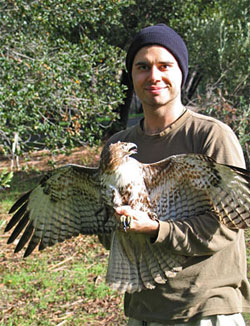Coffee plantations may preserve some bird species in Costa Rica
Coffee plantations may preserve some bird species in Costa Rica
Rhett A. Butler, mongabay.com
June 18, 2007
Agricultural areas offer opportunities for conservation in deforested landscapes in the tropics, reports a study published in the April 2007 issue of the journal Conservation Biology by Stanford University biologists.
Tracking 450 individuals of 11 species of birds in coffee plantations converted from tropical forest in Costa Rica, a team of researchers led by Cagan H. Sekercioglu, senior scientist at the Stanford University Center for Conservation Biology, found that some forest bird species can persist in agricultural landscapes by either adapting to deforested habitats or by moving between the few trees left standing. The results offer hope that small conservation measures could preserve some biological diversity in deforested areas.
“These agricultural landscapes provide a great conservation opportunity,” Sekercioglu told mongabay.com. “Even increasing tree cover by a few percentage points would substantially increase the trees used by these birds. For example, reforesting 11% of the landscape would double the tree cover.”
“Therefore, these human-dominated landscapes should be better integrated into conservation programs rather than being considered hopeless,” Sekercioglu added. “They also offer a great opportunity to restoration ecologists, both for research and for applied conservation.”
“Even though we would like to have big national parks with a lot of forest, sometimes when you can’t have that, when you have to have agriculture, it’s really important to have these reserves of native trees and native forests, which can support large numbers of native birds and other organisms.”
 Cagan H. Sekercioglu with a red-tailed hawk. Photo by Stan Moore |
This study is a product of the largest tropical bird radio tracking project, which has so far involved over 20,000 person hours of observations and more than 32,000 GPS points obtained by physically locating each bird. Sekercioglu says that farmers can boost biodiversity by retaining small forest reserves, strips of forest along waterways and individual trees interspersed throughout agricultural land. Forest corridors can also facilitate the return of bird species to degraded landscapes.
“Our results suggest that the conservation value of working landscapes in the tropics can be boosted significantly with relatively little investment and conflict because remnant trees, riparian strips, forest fragments, and their residents also supply people and domestic animals with fruits, shade, clean water, crop pollination, and other ecosystem services,” Sekercioglu and his co-authors wrote. “A good example can be seen in Monteverde, Costa Rica, where a combination of conservation easements, local education, reforestation, and economic incentives for landowners, including birdwatching ecotourism… has successfully reconnected and expanded the habitat of Resplendent Quetzals
(Pharomacrus mocinno) in the countryside.”
“Similar initiatives are urgently needed to restore tropical countrysides with ecological approaches… such as agroforestry schemes,” the authors continued. “These will reduce the pressures on reserves, maintain essential ecosystem services, improve the biodiversity-carrying capacity of agricultural landscapes, and help integrate them with protected areas.We recommend that significantly more conservation effort be directed at enhancing the conservation value of tropical countryside, thus providing disappearing species with more options.”
While the results are positive, Sekercioglu notes that biodiversity is lower in agricultural areas than in pristine forest. Many bird species appear to avoid coffee plantations.
“Although we caught all these birds in coffee, most of them prefer remnant forest fragments, individual trees and trees along rivers, which are called riparian corridors.” Sekercioglu said. “Most birds don’t like to eat the coffee fruit. Caffeine evolved as a pesticide to keep pests away.”
CITATION: Cagan H. Sekercioglu, Scott R. Loarie, Federico Oviedo Brenes, Paul R. Ehrlich, And Gretchen C. Daily (2007) Persistence of Forest Birds in the Costa Rican Agricultural Countryside. Conservation Biology Volume 21, No. 2, 482—494